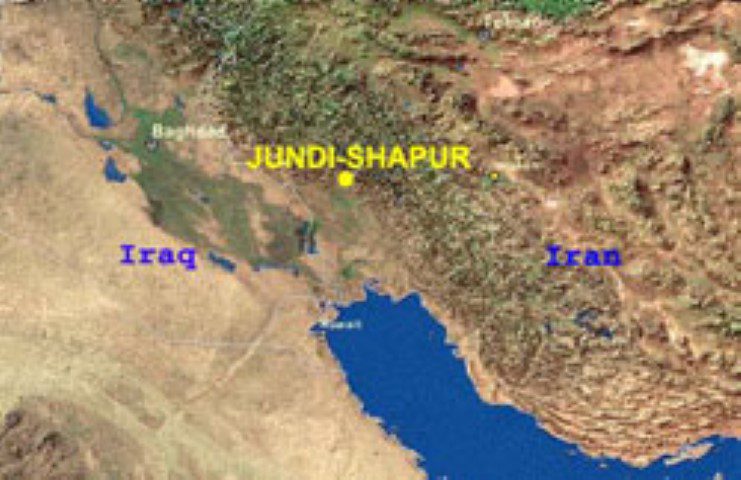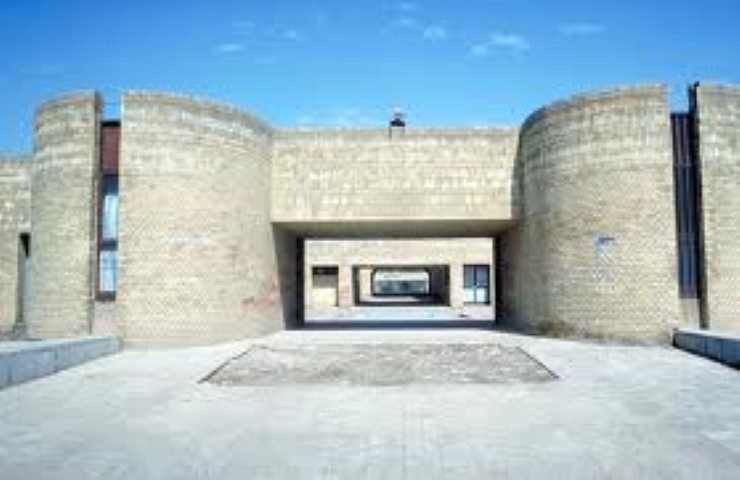Andrew C. Miller
Bethesda, Maryland, United States

With the exception of the hospital at Jundi-Shapur, hospitals and medical centers as we know them are not known to have existed before AD 400.1 In the late Sassanid period, a considerable scientific movement grew in Persia.2 Jundi-Shapur (Genta Shapitra in Pahlavi, Gondi Shapur in Farsi, Beth Lapat in Syriac) meaning “Beautiful Garden,” was a renowned cosmopolitan medical center in Shah-Abad, near Susa, capital of the Elamite (2700 – 539 BC) state Šušan that occupied approximately the same territory as the modern Khūzestān Province.2-5 It was re-established by the second Sassanid king, Shapur I (AD 241-272) after he defeated the Byzantine Emperor Valerian (AD 260) and conquered the city of Antioch.2,3,6 Upon establishing, he renamed the city “Veh-az-Andev-i-Shapur”, which in Pahlavi means “Shapur is better than Antioch”.2,3,6 Finally the name Gondi Shapur emerged but was ultimately replaced by the Arabic equivalent Jundi-Shapur.3 Jundi-Shapur became a prosperous metropolis, refuge, and melting pot for intellectuals from many regions. Shapur II (309-379 A.D.) is credited for conceiving and establishing the nucleus of the university in the latter part of the fourth century.2,3

In AD 431 the priest Nestorius was deposed at the council of Ephesus, and he and his adherents in the Assyrian Church were excommunicated.3 This church controversy profoundly affected the history of medical education. In AD 488 religious controversy flared anew, and Bishop Cyrus of Alexandria persuaded Emperor Zeno to abolish the School of Edessa (Alroha in Arabic), now Urfa (Southwestern Turkey) in AD 489.2,3,5-10 Many Nestorian scholars accepted the asylum offered them by the Sassanid King Shah Kai Kobad.2,5,7-9 The closing of the Athenian school by the Byzantine Emperor Justinian (AD 539) also drove many leaned Greek physicians to Jundi-Shapur.4-6 The Sassanid Empire reached the zenith of its cultural blossoming under Khosrow Anoushiravan (Chosroes Nushirwan) (reign AD 530-578.).11 By his order, a physician named Burzuyah was dispatched on a mission to import medical and other knowledge from India. In AD 550 the first known medical symposium was held by Anoushiravan’s order.2 By the end his reign, Jundi-Shapur had become the greatest intellectual center of the East, developing into a uniquely tolerant and peaceful meeting point for the study of the philosophical and medical traditions of Persians, Greeks, Indians, Zoroastrians, Jews, and Nestorians.
Much of what is known of the organization of the university and medical school is derived from scattered fragments of various works, particularly Ibn Abi Usaybia’s Uyun-al-Abna fi Tabaqat-al-Atibba.3 The university was divided into three major divisions: (1) the school of theology, philosophy, and metaphysics, (2) the institute of translation, and (3) the school of medicine.3 Medical students came mostly from other schools and had already the available preliminary training of that time. As such they often spent only a year or less in this section.3
Opposite the great school was built the famous hospital (Bimaristan). After being prepared in the basic sciences students were assigned in rotating groups to well-known physicians and surgeons at the Bimaristan.3 The teaching hospital was organized into inpatient and outpatient services, and into departments of medicine, surgery, orthopedics, and ophthalmology.3 The director of the hospital, also dean of the medical school, was the most outstanding physician of his day. He was assisted by two deputies, one appointed by the Nestorians and one by the government.3 Jundi-Shapur was not merely a place of teaching or healing, but an environment that fostered academic productivity. The first known pharmacopeia was compiled there by Sabur ibn Saber (AD 869) and adopted by the eastern caliphate, as was a twenty-two volume antidotary (Aqrabadin) that discussed every known poison and its clinical symptoms and treatment.3,6 Other distinctions included the first recorded major medical convention and government sponsored medical debates.3,6 Moreover, Jundi-Shapur appears to have been the first medical school to require standardized licensure examinations.
During the Abbasid Caliphate, Caliph Abu Jaifar Al-Mansur moved the capital from Damascus to Baghdad (AD 762.). When he fell ill in AD 765 he summoned Jirjis ibn Bukhtyishu, the Nestorian Chief Physician of Jundi-Shapur, to cure him.11 After successfully treating the Caliph, Jirjis ibn Bukhtyishu was appointed to the court. His son, Jibrail ibn Bukhtyishu, was later invited to Baghdad during the reign of Caliph Harun Al-Rashid to build the first Bimaristan in Baghdad.5,12 By the latter half of the eighth century, the fame of Baghdad had risen as the political, intellectual, and scientific leader of the caliphate. With the migration of the great teachers to the newer metropolis, students also followed, and the great school faded away. In 1955 a medical school was re-established in Ahvaz, twenty miles south of Shah-Abad and the name Jundi-Shapur was resurrected. The university has three campuses consisting of nine schools, and administers eight public hospitals in Ahvaz as well as twenty other hospitals in the surrounding areas.
References
- Miller, A.C., Jundi-Shapur, bimaristans, and the rise of academic medical centres. J R Soc Med, 2006. 99(12): p. 615-7.
- Azizi, M.H., Gondishapur School of Medicine: the most important medical center in antiquity. Arch Iran Med, 2008. 11(1): p. 116-9.
- Podgorny, G., Islamic-Persian medical education. A survey from Jundi-Shapur to Cairo. N C Med J, 1966. 27(3): p. 135-40 contd.
- Dols, M.W., The origins of the Islamic hospital: myth and reality. Bull Hist Med, 1987. 61(3): p. 367-90.
- Nagamia, H.F., Islamic Medicine History and Current Practice. J Int Soc Hist Islamic Med, 2003. 2: p. 19-30.
- Elgood, C., Jundi Shapur-A Sassanian University: (Section of History of Medicine). Proc R Soc Med, 1939. 32(9): p. 1033-6.
- Johna, S., The Mesopotamian schools of Edessa and Jundi-Shapur: the roots of modern medical schools. Am Surg, 2003. 69(7): p. 627-30.
- Bayon, H.P., Arabic philosopher-physicians and Christian doctors of medicine; a contribution to the knowledge of the origin of the Moslem revival of science and the derivation of the medical profession. Proc R Soc Med, 1952. 45(5): p. 310-4.
- Shanks, N.J. and D. Al-Kalai, Arabian medicine in the middle ages. J R Soc Med, 1984. 77(1): p. 60-5.
- Zikria, B.A., Historical Notes – Ruhawi. JIMA, 1978. 9(1): p. 26.
- Sa’Di, L.M., Glimpses into the history of Arabic medicine. Bull Med Libr Assoc, 1958. 46(2): p. 206-18.
- Savage-Smith, E. A Brochure to Accompany an Exhibition in Celebration of the 900th Anniversary of the Oldest Arabic Medical Manuscript in the Collections of the National Library of Medicine. Islamic Culture and the Medical Arts 1994 [cited 2013 November 18]; Available from: http://www.nlm.nih.gov/exhibition/islamic_medical/islamic_00.html.
ANDREW C. MILLER, MD, completed training programs in emergency medicine, internal medicine, and pulmonary and critical care medicine. He is a highly published medical researcher who also maintains continued interest in medical history and the evolution of medical education. Dr. Miller currently practices critical care medicine at the National Institutes of Health.
Highlighted in Frontispiece Volume 7, Issue 3 – Summer 2015 and Volume 13, Issue 4 – Fall 2021

Leave a Reply